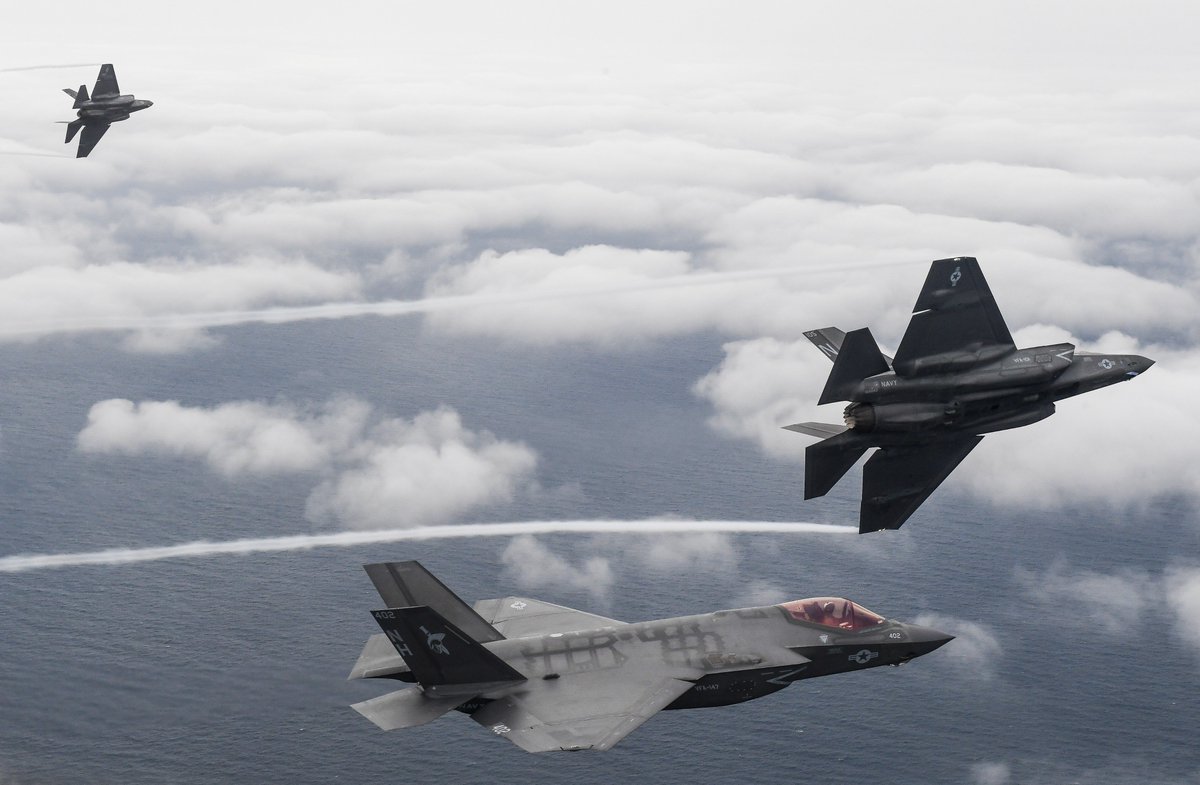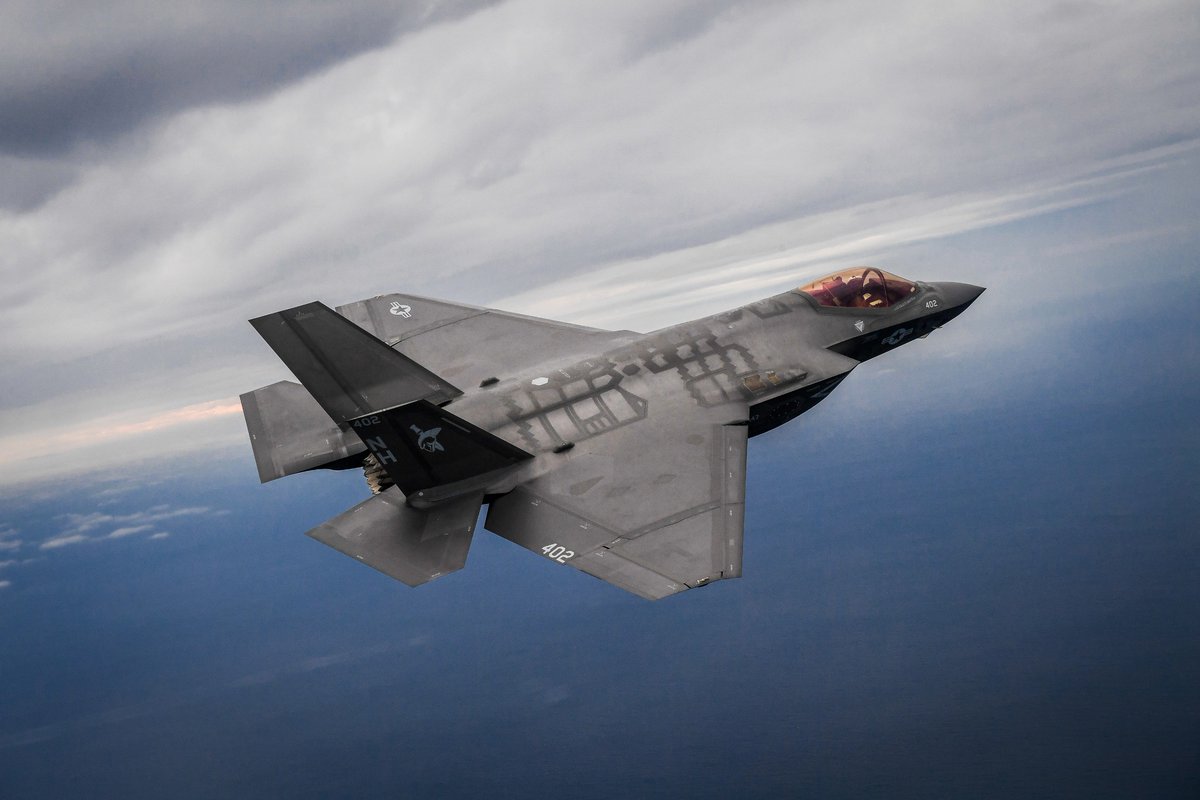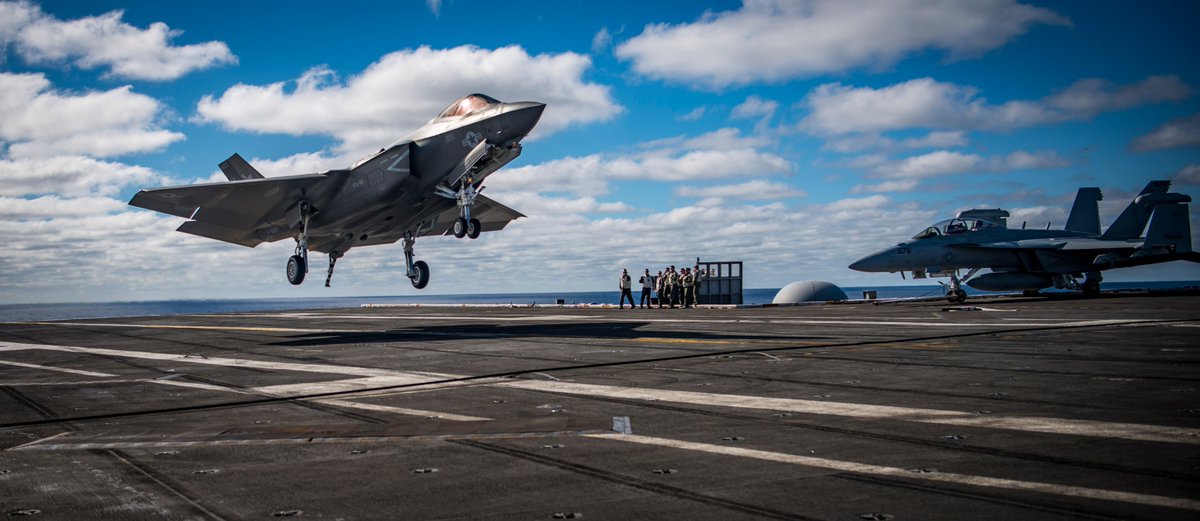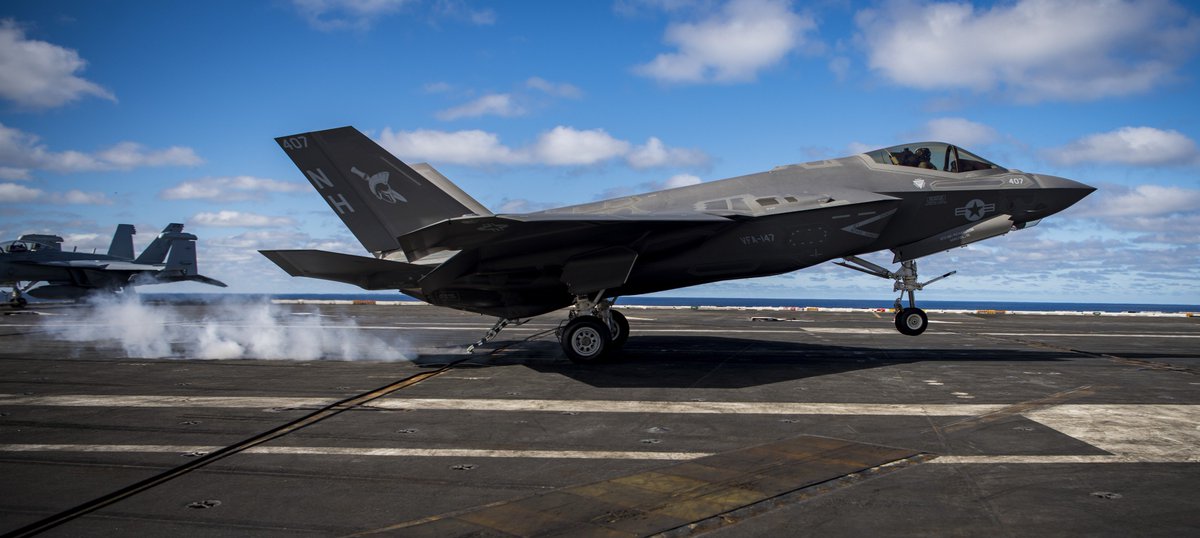F-35 Lightning II (Lockheed Martin)
- Téma indítója GrGLy
- Indítva
-
- Címkék
- cf-35a joint strike fighter jsf x-35
You are using an out of date browser. It may not display this or other websites correctly.
You should upgrade or use an alternative browser.
You should upgrade or use an alternative browser.
Az új szerződés leviszi az F-35A árat 90 millió dollár alá
https://defense-update.com/20180928_lrip11_below90mil.html
https://defense-update.com/20180928_lrip11_below90mil.html
Hollandiában nem felhőtlen az öröm.
"Január végén Hollandia megkapta az első JSF-et. Az átadás ünnepi volt, de az amerikai szabályozói jelentések felvetik a hibás eszköz képét: megoldatlan hibák, túl alacsony megbízhatóság és túl magas karbantartási igény. ... Tizenöt korlátozás olyan jellegű, hogy veszélyeztetheti a személyzet biztonságát. A másik 87 hiányosság akadályozhatja vagy korlátozhatja a misszió sikeres befejezését. "
https://www.ftm.nl/artikelen/nederl..._campaign=Arne-van-der-Wal&utm_source=twitter
"Január végén Hollandia megkapta az első JSF-et. Az átadás ünnepi volt, de az amerikai szabályozói jelentések felvetik a hibás eszköz képét: megoldatlan hibák, túl alacsony megbízhatóság és túl magas karbantartási igény. ... Tizenöt korlátozás olyan jellegű, hogy veszélyeztetheti a személyzet biztonságát. A másik 87 hiányosság akadályozhatja vagy korlátozhatja a misszió sikeres befejezését. "
https://www.ftm.nl/artikelen/nederl..._campaign=Arne-van-der-Wal&utm_source=twitter
"U.S. Navy should redesign the F-35C to perform a future role as a fleet defense fighter and long-range bomber escort.
The recommendation by Center for Strategic and Budgetary Analysis (CSBA) analyst Bryan Clark is included in a newly-published report that urges the Navy to rethink the current composition of the carrier air wing.
As a stealthy aircraft packed with targeting systems and weapons, the F-35C is designed to perform ground attack and air-to-air missions. But its 670 nm maximum combat radius falls short of the range the Navy needs for a future role in the Pacific theater, Clark argues.
In a theoretical conventional war with China, CSBA’s analysis concluded that aircraft carriers must operate 1,000 nm east of the rising Asian power’s coastline. The ground attack mission would have to be taken over by a future unmanned combat air vehicle (UCAV) instead of the F-35C, Clark says.
At the same time, the Navy will also need a more capable frontline fleet defense fighter, he adds. The F-35C and the F/A-18E/F were designed to perform a multirole mission. Clark argues that the carrier air wing needs an aircraft optimized to perform as an air-to-air fighter. The so-called F/A-XX could perform long-distance fleet defense missions and escort Air Force bombers if Chinese missiles disable the runways on land bases for F-22s, F-35s and F-15s.
Instead of designing the F/A-XX from a clean-sheet, Clark suggests that Lockheed could redesign the F-35C to perform that role. It would require integrating a more efficient propulsion system and conformal fuel tanks, he says. The funding would come from truncating the Navy’s planned F-35C order after half the aircraft are delivered, he says, but the development phase should begin now.
“That would allow the Navy to get the more specialized aircraft it needs for a higher threat environment we’re facing in the future,” Clark says."
The recommendation by Center for Strategic and Budgetary Analysis (CSBA) analyst Bryan Clark is included in a newly-published report that urges the Navy to rethink the current composition of the carrier air wing.
As a stealthy aircraft packed with targeting systems and weapons, the F-35C is designed to perform ground attack and air-to-air missions. But its 670 nm maximum combat radius falls short of the range the Navy needs for a future role in the Pacific theater, Clark argues.
In a theoretical conventional war with China, CSBA’s analysis concluded that aircraft carriers must operate 1,000 nm east of the rising Asian power’s coastline. The ground attack mission would have to be taken over by a future unmanned combat air vehicle (UCAV) instead of the F-35C, Clark says.
At the same time, the Navy will also need a more capable frontline fleet defense fighter, he adds. The F-35C and the F/A-18E/F were designed to perform a multirole mission. Clark argues that the carrier air wing needs an aircraft optimized to perform as an air-to-air fighter. The so-called F/A-XX could perform long-distance fleet defense missions and escort Air Force bombers if Chinese missiles disable the runways on land bases for F-22s, F-35s and F-15s.
Instead of designing the F/A-XX from a clean-sheet, Clark suggests that Lockheed could redesign the F-35C to perform that role. It would require integrating a more efficient propulsion system and conformal fuel tanks, he says. The funding would come from truncating the Navy’s planned F-35C order after half the aircraft are delivered, he says, but the development phase should begin now.
“That would allow the Navy to get the more specialized aircraft it needs for a higher threat environment we’re facing in the future,” Clark says."
M
molnibalage
Guest
"U.S. Navy should redesign the F-35C to perform a future role as a fleet defense fighter and long-range bomber escort.
The recommendation by Center for Strategic and Budgetary Analysis (CSBA) analyst Bryan Clark is included in a newly-published report that urges the Navy to rethink the current composition of the carrier air wing.
As a stealthy aircraft packed with targeting systems and weapons, the F-35C is designed to perform ground attack and air-to-air missions. But its 670 nm maximum combat radius falls short of the range the Navy needs for a future role in the Pacific theater, Clark argues.
In a theoretical conventional war with China, CSBA’s analysis concluded that aircraft carriers must operate 1,000 nm east of the rising Asian power’s coastline. The ground attack mission would have to be taken over by a future unmanned combat air vehicle (UCAV) instead of the F-35C, Clark says.
At the same time, the Navy will also need a more capable frontline fleet defense fighter, he adds. The F-35C and the F/A-18E/F were designed to perform a multirole mission. Clark argues that the carrier air wing needs an aircraft optimized to perform as an air-to-air fighter. The so-called F/A-XX could perform long-distance fleet defense missions and escort Air Force bombers if Chinese missiles disable the runways on land bases for F-22s, F-35s and F-15s.
Instead of designing the F/A-XX from a clean-sheet, Clark suggests that Lockheed could redesign the F-35C to perform that role. It would require integrating a more efficient propulsion system and conformal fuel tanks, he says. The funding would come from truncating the Navy’s planned F-35C order after half the aircraft are delivered, he says, but the development phase should begin now.
“That would allow the Navy to get the more specialized aircraft it needs for a higher threat environment we’re facing in the future,” Clark says."
Na ez most azért vicces, mert pár éve azon keseregtek, hogy éppencsak nem jött össze a 600 nm range. Akkor most mi van? Ráadásul ez a gép került legközelebb a kiszórt A-6E hatósugarához. Ennyi volt az elvárás.Ez még mindig a régi nóta.
Aztán most esik le, hogy 1000 nm nem jön össze? Bárki komolyan gondolja, hogy ez lehetséges deckről légi utántöltés nélkül...? Egy taktikai gépek volt ekkora hatósugara kb. az F-111-esnek. Na, nem is üzemelt deckről...
Mi köze ehez egy pénzügyi tervezőnek?"U.S. Navy should redesign the F-35C to perform a future role as a fleet defense fighter and long-range bomber escort.
The recommendation by Center for Strategic and Budgetary Analysis (CSBA) analyst Bryan Clark is included in a newly-published report that urges the Navy to rethink the current composition of the carrier air wing.
As a stealthy aircraft packed with targeting systems and weapons, the F-35C is designed to perform ground attack and air-to-air missions. But its 670 nm maximum combat radius falls short of the range the Navy needs for a future role in the Pacific theater, Clark argues.
In a theoretical conventional war with China, CSBA’s analysis concluded that aircraft carriers must operate 1,000 nm east of the rising Asian power’s coastline. The ground attack mission would have to be taken over by a future unmanned combat air vehicle (UCAV) instead of the F-35C, Clark says.
At the same time, the Navy will also need a more capable frontline fleet defense fighter, he adds. The F-35C and the F/A-18E/F were designed to perform a multirole mission. Clark argues that the carrier air wing needs an aircraft optimized to perform as an air-to-air fighter. The so-called F/A-XX could perform long-distance fleet defense missions and escort Air Force bombers if Chinese missiles disable the runways on land bases for F-22s, F-35s and F-15s.
Instead of designing the F/A-XX from a clean-sheet, Clark suggests that Lockheed could redesign the F-35C to perform that role. It would require integrating a more efficient propulsion system and conformal fuel tanks, he says. The funding would come from truncating the Navy’s planned F-35C order after half the aircraft are delivered, he says, but the development phase should begin now.
“That would allow the Navy to get the more specialized aircraft it needs for a higher threat environment we’re facing in the future,” Clark says."
Na, nem is üzemelt deckről...
Azért szándék volt rá.

A szándék és a tény az sajnos nem mindig ugyanaz.Azért szándék volt rá.

Nekem is voltak szándékaim sok csajjal, aztán vagy bejött vagy nem ...


"U.S. Navy should redesign the F-35C to perform a future role as a fleet defense fighter and long-range bomber escort.
The recommendation by Center for Strategic and Budgetary Analysis (CSBA) analyst Bryan Clark is included in a newly-published report that urges the Navy to rethink the current composition of the carrier air wing.
As a stealthy aircraft packed with targeting systems and weapons, the F-35C is designed to perform ground attack and air-to-air missions. But its 670 nm maximum combat radius falls short of the range the Navy needs for a future role in the Pacific theater, Clark argues.
In a theoretical conventional war with China, CSBA’s analysis concluded that aircraft carriers must operate 1,000 nm east of the rising Asian power’s coastline. The ground attack mission would have to be taken over by a future unmanned combat air vehicle (UCAV) instead of the F-35C, Clark says.
At the same time, the Navy will also need a more capable frontline fleet defense fighter, he adds. The F-35C and the F/A-18E/F were designed to perform a multirole mission. Clark argues that the carrier air wing needs an aircraft optimized to perform as an air-to-air fighter. The so-called F/A-XX could perform long-distance fleet defense missions and escort Air Force bombers if Chinese missiles disable the runways on land bases for F-22s, F-35s and F-15s.
Instead of designing the F/A-XX from a clean-sheet, Clark suggests that Lockheed could redesign the F-35C to perform that role. It would require integrating a more efficient propulsion system and conformal fuel tanks, he says. The funding would come from truncating the Navy’s planned F-35C order after half the aircraft are delivered, he says, but the development phase should begin now.
“That would allow the Navy to get the more specialized aircraft it needs for a higher threat environment we’re facing in the future,” Clark says."
Na igen, miután a légierő kategórikusan kijelentette, hogy nem hajlandó közösködni sem az USNAVY, sem a MARINES baromságaival (lásd az F-35-re hogyan akaszkodtak rá), most lábon vannak lőve.
A PCAt az USAF tiszta ATF jellegű programként akarja futtatni saját magának, a két másik haderő baromságait mellőzve, vagyis azok nem használhatják erre kvázi az AF forrásait (mert a jelenlegi szintű F-35C/B-re maguknak aligha lett volna pénzük). Vagyis az F/A-XX saját forrásból kéne menjen, amire már rájöttek, hogy nem tudják kibulizni, így megy a keresgélés, mi legyen. próbálnak most a C-ből minél többet kihozni.
Az F/A-XX egy Tomcat hatótávolságú légfölény+attack gép lenne - de az annyiba kerülne alaphangon más most, hogy a csodás hajóprogramjaik mellett ez nem fog kijönni - az AF viszont egy elég tartható ütemtervet rakott össze.
(Elkezdtem írni egy összefoglalást az NGAD/PCA/F/A-XX jelenlegi állásáról, majd felfdobom ha kész lesz).
Az európai karbantartási rendszer részei:
"The F-35 programme is based on a global support solution concept. This is the most cost effective way to deliver the F-35 support solution and is based on economies of scale,"
"The UK is establishing an F-35 airframe maintenance facility at RAF Marham to maintain UK aircraft.
Regional Airframe 'Heavy' MRO&U and Engine MRO&U will be undertaken in Italy and Turkey."
Britain must send its F-35s to Italy for heavy overhauls and ship the engines to Turkey for overhauls and upgrades
BAE Systems will maintain an airframe maintenance, repair, overhaul and upgrade (MRO&U) capability at RAF Marham
The U.S. Government selected the FACO in Cameri to be the European Maintenance, Repair, Overhaul and Upgrade Center of Excellence
European maintenance hub in the Netherlands
The US Department of Defense announced today that the Netherlands will store all the parts of the F-35 airplanes in Europe. The Netherlands will be responsible for storage, shipping and management of spare parts of over four hundred F-35s for the coming decades. The Royal Air Force Logistics Center Woensdrecht (LCW) will hold main responsibility for the storage of the equipment. In addition, some 70 Dutch companies will benefit from this contract.
Maintenance on the F-35 will be handled in a smart way. The components are stored in a central warehouse in the Netherlands. From there, they can quickly be packaged and shipped, with customs clearance and export licenses. The European Warehouse at the LCW will also have a post at Schiphol, because transport not only goes by road, but also by air. A so-called control tower streamlines logistics processes. With the approach proposed by the Netherlands, logistics costs are kept low, stocks optimized and the availability of F-35 devices ensured. The Pentagon chose the Dutch proposal because of this integrated approach.
The new warehouse is the first step towards a modern logistics concept for F-35 parts in Europe. Additionally, it shows that The Netherlands is a leader in logistics.
Engine maintenance
The Netherlands was previously selected as one of the four countries that will service the engines of the new fighter aircrafts, together with Australia, Norway and Turkey. At the LCW, a test facility and workshop are being built as part of the global maintenance infrastructure for the F-35 engines. In addition to engine maintenance, the F-35 starter engine and landing mechanism, this is the fourth success in maintaining the F-35 for the Netherlands in a short period of time.
The maintenance center, currently under construction at Rygge Air Base, is planned to serve US-made fighter jets from across Europe.
"The F-35 programme is based on a global support solution concept. This is the most cost effective way to deliver the F-35 support solution and is based on economies of scale,"
"The UK is establishing an F-35 airframe maintenance facility at RAF Marham to maintain UK aircraft.
Regional Airframe 'Heavy' MRO&U and Engine MRO&U will be undertaken in Italy and Turkey."
Britain must send its F-35s to Italy for heavy overhauls and ship the engines to Turkey for overhauls and upgrades
BAE Systems will maintain an airframe maintenance, repair, overhaul and upgrade (MRO&U) capability at RAF Marham
The U.S. Government selected the FACO in Cameri to be the European Maintenance, Repair, Overhaul and Upgrade Center of Excellence
European maintenance hub in the Netherlands
The US Department of Defense announced today that the Netherlands will store all the parts of the F-35 airplanes in Europe. The Netherlands will be responsible for storage, shipping and management of spare parts of over four hundred F-35s for the coming decades. The Royal Air Force Logistics Center Woensdrecht (LCW) will hold main responsibility for the storage of the equipment. In addition, some 70 Dutch companies will benefit from this contract.
Maintenance on the F-35 will be handled in a smart way. The components are stored in a central warehouse in the Netherlands. From there, they can quickly be packaged and shipped, with customs clearance and export licenses. The European Warehouse at the LCW will also have a post at Schiphol, because transport not only goes by road, but also by air. A so-called control tower streamlines logistics processes. With the approach proposed by the Netherlands, logistics costs are kept low, stocks optimized and the availability of F-35 devices ensured. The Pentagon chose the Dutch proposal because of this integrated approach.
The new warehouse is the first step towards a modern logistics concept for F-35 parts in Europe. Additionally, it shows that The Netherlands is a leader in logistics.
Engine maintenance
The Netherlands was previously selected as one of the four countries that will service the engines of the new fighter aircrafts, together with Australia, Norway and Turkey. At the LCW, a test facility and workshop are being built as part of the global maintenance infrastructure for the F-35 engines. In addition to engine maintenance, the F-35 starter engine and landing mechanism, this is the fourth success in maintaining the F-35 for the Netherlands in a short period of time.
The maintenance center, currently under construction at Rygge Air Base, is planned to serve US-made fighter jets from across Europe.
A Red Flag az marketing vagy valós szimuláció?
Mert csak a "kill ratio" alapján meg kell várni míg a a környék bevásárol F-16-ból és venni két századot ebből a csodagépből
Hát sok milliárd dollár, amit erre elköltenek elég drága marketing lenne

Konkrétan azért van megtartva a mai napig a szuperszámítógépek korában is (amelyek aztán lassan mindent leszimulálnak), mert a legjobban képes hozni egy valód konfliktus minden szintjét (és itt most nem csak a gépek közti összecsapásokra kell gondolni, hanem a maintenance, az irányítás, a logisztika számára is kőkemények ezek a gyakorlatok). Ott konkrétan a hangárokban és műhelyekben pl. szimulálják, hogy a legmagasabb hardrafoghatóságot elérjék, a sérült gépek fogadását és javítását, kibertámadás esetén hogy maradjon zavartalan a kiszolgálás, stb. A levegeőben meg nyilván az aktuális ellenséget meg újabban az A2/AD áttörést (legalábbis amit hallottam meg kihámoztam a videókból).
Maga a kill ratio az egy érdekes szám, mert nem tuduk, hányas felállás, kinek volt AWACS támogatás, hány stealth gép vett részt oldalanként - vagyis a lényeget.
De az F-22-es számaival összevetve adhat egy valós képet (124:1) - főleg, hogy ez egy csapásmérő.... végül is egy alaposan megtervezett szerkentyű, nem a semmiért került ennyibe. A képességeknek ára van.
Szerintem simán megérné venni, a későbbi szériákból, a gripenek kifutására, de ez totál magánvélemény, biztos cáfolható.
Molni válasza a Magyarország légvédelme topikból, a "mi lesz a török F-35 sorsa kérdésre":
"Megkapja más F-35 export megrendelő vagy az USAF. Olyannyira fogy az F-16-osok óraszáma, hogy most akarnak F-15X-eket vagy mit vetetni az USAF-fal. Akkor fogják és USAF megkapja azokat.
Nem probléma az sem, ha kicsit át kell építeni őket emiatt más specifikáció szerint. Kicsivel több munkaóra. Ennyi."
OK. Köszi.
Mostanában olvastam valahol, hogy az F-35A-k üzemeltetése csak 10%-al drágább az F-16-nál (USAF).
Most úgy néz ki, hogy a Gripenek maradványértéke 2026-ban - amennyiért megvásárolhatjuk - az a piaci ára a gépeknek. Tehát nem törlesztettünk semmit a gépek árából, kvázi béreljük őket. Ha nem így van akkor az F-35-ön gondolkodás tényleg teljesen kacsa kell legyen. Ha viszont így van, az azt jelenti, hogy a Gripen üzemeltetése sokkal drágább az F-16-nál, sőt az F-35-nél is drágább lehet. Tehát így nézve nem is teljesen irracionális ötlet az F-35.
"Megkapja más F-35 export megrendelő vagy az USAF. Olyannyira fogy az F-16-osok óraszáma, hogy most akarnak F-15X-eket vagy mit vetetni az USAF-fal. Akkor fogják és USAF megkapja azokat.
Nem probléma az sem, ha kicsit át kell építeni őket emiatt más specifikáció szerint. Kicsivel több munkaóra. Ennyi."
OK. Köszi.
Mostanában olvastam valahol, hogy az F-35A-k üzemeltetése csak 10%-al drágább az F-16-nál (USAF).
Most úgy néz ki, hogy a Gripenek maradványértéke 2026-ban - amennyiért megvásárolhatjuk - az a piaci ára a gépeknek. Tehát nem törlesztettünk semmit a gépek árából, kvázi béreljük őket. Ha nem így van akkor az F-35-ön gondolkodás tényleg teljesen kacsa kell legyen. Ha viszont így van, az azt jelenti, hogy a Gripen üzemeltetése sokkal drágább az F-16-nál, sőt az F-35-nél is drágább lehet. Tehát így nézve nem is teljesen irracionális ötlet az F-35.
Mostanában olvastam valahol, hogy az F-35A-k üzemeltetése csak 10%-al drágább az F-16-nál (USAF).
Vezetésnek el kell dönteni hogy akarnak-e valós légifölényt vagy sem ennyiért. Ha igen akkor lesz F-35, ha nem akkor marad a Gripen(vagy a romló kapcsolatokat elnézve még az F-16-ot se zárnám ki...).

Vezetésnek el kell dönteni hogy akarnak-e valós légifölényt vagy sem ennyiért. Ha igen akkor lesz F-35, ha nem akkor marad a Gripen(vagy a romló kapcsolatokat elnézve még az F-16-ot se zárnám ki...).
Igen, ez egy kicsit más mutat...
Anno itt találtam az infót, mondjuk nem mai cikk:
https://honvedelem.hu/cikk/37749_tobbe_kerulhet_az_f35ak_uzemeltetese_mint_az_f16_osoke
Ott az F-16 van túlárazva, ha jól látom, az F-35A-ra 24.000-et mond.
Ha a Gripen esetében mi nem törlesztjük a vételárat évente, akkor az vagy egy baromi drága bérlet, vagy a Jane's téved a 4700-at illetően.






